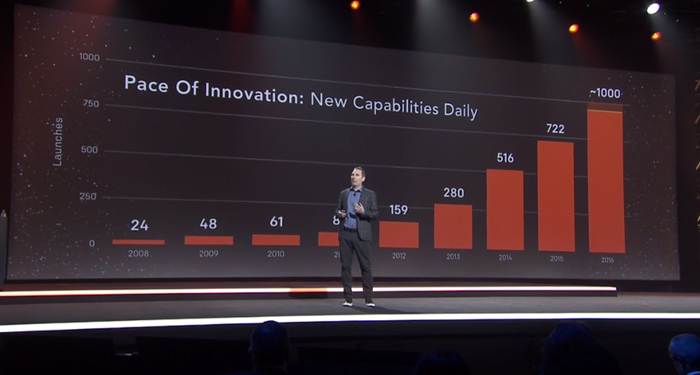Salesforce to Offer Core Applications on AWS in 2017
Amazon Web Services, Inc., an Amazon.com company, and CRM giant Salesforce announced on Friday the expansion of their global strategic alliance. The partnership delivers five new service integrations and marks the first time that core Salesforce applications are available in a public cloud. Salesforce customers can now use their Service Cloud, Sales Cloud, Community Cloud, Analytics Cloud and more, on the AWS Cloud infrastructure. Starting in mid-2017, Canada will be the first new region supported in Salesforce's international infrastructure expansion on AWS. Other countries will follow.
"We're thrilled to extend our great partnership with AWS," said Marc Benioff, Chairman and CEO, Salesforce.  "Integrating AWS' industry-leading infrastructure services and technologies with Salesforce will bring even more exceptional solutions to our customers."
"Integrating AWS' industry-leading infrastructure services and technologies with Salesforce will bring even more exceptional solutions to our customers."
Salesforce and Amazon have been getting cozy since Benioff spoke highly of Amazon Web Services during one of Salesforce’s earning calls and revealed its plans to build new products on AWS and to offer some of its older software on Amazon’s infrastructure as well. Moreover, the Salesforce’s 10Q statement unveiled that Salesforce would spend $400 million on AWS services over the next four years. With the announcement of the expansion of the strategic partnership, that tidbit came to light. Also, in May, Salesforce chose Amazon as its "preferred cloud partner" and said that they would use AWS as its international data center in regions where Salesforce doesn’t have its own data center for its biggest apps, including its flagship customer relationship management apps.
What Does it Mean for Salesforce?
What the deeper relationship means for Salesforce is that the CRM giant can now benefit from Amazon’s giant data centers in 14 regions across the world, meaning the company will no longer need to invest more of its own. On that note, with one in Montreal, there are four more scheduled data centers to be released soon. However, Salesforce will also maintain its own data centers. This extended partnership begs a question, though: Will Salesforce move all of its software to the public cloud, although it relies on Oracle databases? Recently released Salesforce products, such as its IoT and Internet of Things Cloud, were already built to run on AWS.
New Service Integrations
Under the global strategic alliance, both the companies will provide integrations of Salesforce Platform with Amazon Alexa, Amazon AppStream 2.0, Amazon Redshift, Amazon Virtual Private Cloud (VPC), and AWS IoT.
-
Amazon AppStream 2.0 will be available as a Lightning Component in the Salesforce AppExchange which will allow seamless and easy integration of AWS Cloud-based streaming applications directly within Salesforce. Amazon AppStream 2.0 is also a fully managed secure application streaming service.
-
AWS IoT will connect to Salesforce IoT Cloud which will combine IoT device data with the customer data in Salesforce to enable organizations to deliver meaningful customer experiences based on the real-time activity on their connected devices.
-
Amazon Redshift will be connected to Salesforce Wave Analytics which will allow quick and easy analysis of large data sets. - Amazon Redshift is a fully managed petabyte-scale data warehouse service.
-
The Alexa Toolkit for Salesforce will enable developers to build Smart Voice Apps and voice-enabled experiences, and the toolkit will be available through Trailhead, Salesforce’s learning platform. The new integration is expected to be available to customers in the first half of 2017 at no additional cost.
-
Amazon VPC (Virtual Private Cloud) Peering for Salesforce Heroku Private Spaces will allow organizations to connect their Heroku applications to Amazon VPCs with all the security and compliance benefits of a private network. The integration makes the process as simple as connecting two Amazon VPCs and provides the same security characteristics as well. This integration is currently in beta and expected to be available in the first half of 2017 to Heroku Private Spaces customers at no additional cost.
What Does it Mean for Amazon Web Services?
Amazon Web Services frees companies from maintaining their own IT infrastructure as it already provides them high-end computing infrastructure as well as tools that support website production, social media, and mobile applications. All of these do not only carry the company to the top of the IaaS space but also make AWS the cash cow for Amazon as, by itself, Amazon Web Services is worth $160 billion, or 44% of Amazon's enterprise value.
In the public cloud space, AWS is the undisputed leader, well ahead of Microsoft, Alphabet, and IBM. In fact, "with new features and services in 2016 on track to hit 1,000 (vs. 722 new features introduced in 2015), the pace of AWS innovation is hard to match by any of its competitors," Jefferies analyst Brian Fitzgerald wrote in a report. It means that AWS will continue to receive the lion’s share of the lucrative cloud computing space as the new cloud applications will enable the company to compete even more directly with large enterprise software providers which also means new challenges for Microsoft, Oracle, and others. Not to mention Salesforce’s flagship CRM offering competes with Microsoft’s Dynamics CRM.

Source: Business Insider
Another question that this strengthened partnership raises is: How will these integrations affect the cut-throat competition between Amazon and Oracle? "We have a hard time seeing how the growth of AWS will not do major damage to Oracle's database business for various reasons," Patrick Walravens of JMP Securities wrote in a report about the AWS conference, stating that large Italian energy group Enel, McDonald's (MCD) , and financial regulator FINRA are all using AWS. The announcement of the expanded partnership came at the company’s fifth annual re:Invent conference, which drew 32,000 people from diverse industries to Las Vegas. During his keynote speech, Andy Jassy, CEO of AWS, took on Oracle and presented a slide proclaimed Amazon freed users from “customer hostile database vendors,” showing part of the red Oracle logo as the letter “O” in hostile. This move has been read as a counterattack as Oracle Chairman Larry Ellison said: “Amazon’s lead is over," during his company’s OpenWorld keynote when he introduced new cloud products. He also commented on the partnership: "We are excited to expand our strategic relationship with Salesforce," he said and added: "These new integrations across business intelligence, IoT, and developer tools will make it easier for our joint customers to analyze data and build new applications." If you would like to hear more on the leadership principles and culture at AWS from Andy Jassy, I would recommend watching the video interview done by theCUBE:
According to Gartner Research, the worldwide public cloud services market is projected to grow 17.2 percent this year totaling up to more than $208 billion. That’s up from $178 billion in 2015. The highest growth will come from cloud system infrastructure services like IaaS, Gartner said, while cloud application services such as SaaS is still the largest segment overall in terms of specific cloud growth at more than 21 percent.
My Take
After all, from the users’ point of view, the purpose of the five new service integrations is to provide better digital experience and allowing them to analyze the captured data and to help simplify the decision-making process. From Amazon’s perspective, this is a great move to get additional muscle in the cloud war and get more share from the large enterprise software companies. Even though startups might be what helped ASW thrive quickly in the cloud computing space, large corporations are the key to maintaining its leadership in today’s marketplace where the number of bigger institutions that adopt cloud are predicted to blossom in the near future. From Salesforce’s standpoint; Benioff has always embraced the growth strategy and been consistently looking for new opportunities to generate new growth for the company, which is already the world’s fourth-largest enterprise software vendor, with approximately 45% of the sales-software market. No wonder why strengthening its partnership with the decade-old Amazon Web Services will be one of the milestones for the company.

Venus Tamturk
Venus is the Media Reporter for CMS-Connected, with one of her tasks to write thorough articles by creating the most up-to-date and engaging content using B2B digital marketing. She enjoys increasing brand equity and conversion through the strategic use of social media channels and integrated media marketing plans.